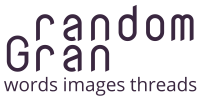An investigation into identity leads to a typographical self-portrait.
This blog is about a month old now, and it feels like time to tell you more about Random Gran, aka Helen F Miller.
Two days ago, Dylan Alcott was announced Australian of the Year for 2022. Wheelchair mobile all his life, he could never hide his disability. On the other hand, I have also been disabled all my life, but was able to hide it for some years. Now, like Dylan, I spend a lot of time in a wheelchair.
Why would I hide it? My reasons are not uncommon. People with disabilities are discriminated against in most spheres of life, especially the workplace. To keep your limitations out of the equation makes life a little easier.
Now that I cannot hide my physical limitations in public any longer, I considered hiding them online by not mentioning them in relation to Random Gran. I feared rejection from readers.
Dylan’s speech when accepting the Australian of the Year award changed my mind. I still expect some rejection, but if disabled people all over do not put their hand up and say, ‘Hi! I’m here too, an intelligent, creative, capable person’, public perception will not change.
In my experience, the greatest disability displayed in our society is suffered by people who think they are not disabled. It is their impaired attitude towards disabled people and other minority groups that limits their own capacities.
Creativity Driver
Without my disability, I would not have lived my life as I have. I would not have been limited to chair bound occupations. My studies would have taken a different path. I would not have lived in the houses and places I have enjoyed. Most importantly, I would not have used the great opportunity to hone my creative skills.
A lot of people have found new ways to entertain themselves during Covid lockdowns and isolations. For me, life did not change; I was keeping busy and occupied at home with my already well-developed interests.
Identity
For a time I felt as if no matter what I did, it was not good enough to be accepted as an equal. No matter how well I did in my studies, or how hard I worked in my job, I would never be equal. My mother warned me as a child that it would be like that, but I thought she was wrong. I struggled with my identity for a long time; even now it can be hard to accept I have done nothing wrong when someone sees my wheelchair instead of me.
When studying a digital art subject a few years ago, we were asked to draw a self-portrait. It gave me an opportunity to examine my identity. One of my strengths that sustains me when times get rough is my mind. The self portrait had to reflect how much I rely on my mind.
Self Portrait
I had a new love of typography and decided to use it to create the hair. The words spelled out my interests in handicrafts, writing, reading, digital design, study, etc. While the face outline is from a photograph of me, I left it blank, as I still wanted to hide from the hurtfulness of discrimination.
The colour is also important. I used a lot of purple in my designs, so the tutor suggested I create my signature purple, one not used elsewhere. This I did and searched the internet for other uses of that colour. Even when I entered its HEX number into the Adobe colour wheel, the program automatically changed the number. I had my signature purple.
It is the colour of the self-portrait, another aspect of my identity. It is also the basis for the colour scheme of the Random Gran website.



The Olde English letters (font) make it look like real hair with curls or waves in it. Good choice.
Thank you. I tried a variety of fonts and liked that one best, even though I don’t have any curls. 🙂